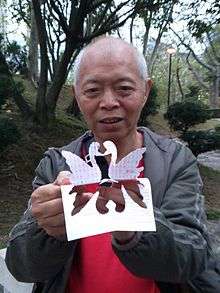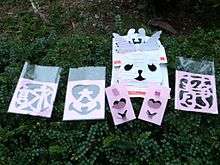Lee Sing-man
| Lee Sing-man | |
|---|---|
 "Uncle Man" with his art | |
| Born |
1944[Note 1] Guangdong, China |
| Other names | Uncle Man |
Lee Sing-man (born 1944), commonly known as "Uncle Man", is a paper-tearing artist in Hong Kong.
He was once a volunteer in Kowloon Walled City Park, creating his works there,[1] before he was invited to demonstrate in Tsim Sha Tsui and became known.[2]
Biography
Early life and education
Lee Sing-man was born in 1944[Note 1] in Guangdong, China, and attended primary school there. At a young age, he was very naughty and did not focus in school. In order to get into secondary school, he had to pass an exam, making it a hindrance to him. Nevertheless, he persevered and passed the exam on the sixth attempt. When he was around fourteen years old in 1958, he moved to Hong Kong and continued his studies.[3] Right after graduating from a secondary school, he studied business administration for a year and moved to Chinese literature. Eventually, he ended his undergraduate studies because his family objected to it, and he began to work.
At first, he worked at his cousin's watch company. He then worked as a quality control checker in a garment factory, followed by a debt collector in a stationery wholesale company, then a delivery courier.[1] It was during this time that he started doing paper-tearing. According to him, working as a local delivery courier was toilsome, but delighting. He usually gave out his paper-tearing artwork to the companies while delivering goods to them. Of course, he was very pleased to see the companies decorating their offices with his creations.[4]
Soon he became famous for paper-tearing. Consequently, he resigned the job of delivery courier due to increasing paper-tearing lessons, performances and voluntary work, and he started to concentrate on promoting paper-tearing art.
1983-1999: paper-tearing

During the Lunar New Year's Eve in 1983, Uncle Man created his first paper-tearing work. It was composed of the two Chinese characters "Dai Kat" (大吉), which means an expectation of a great fortune. Remarkably, he made it out of boredom with no one teaching him. Although the artwork was appreciated by his relatives, he did not have great affections towards paper-tearing at that moment.[2] It was only after he created his second paper-tearing piece during his work as a delivery man that he started to practice his skill. His second work was interpreted as "A million gold pieces". Afterwards, he started giving his artwork to his friends as gifts.[1]
Uncle Man tears paper according to the order of strokes of the word. He practices by adding symmetrical features to words, figures and even three-dimensional words. In fact, in order to promote paper-tearing skills, he made a lot of effort to decrease the number of steps and have fun at the same time, so that even a two-year-old child can both learn and enjoy making them.[5] He usually uses recycled paper for his artwork in the hopes of protecting the environment and making paper-tearing popularized. For instance, he teaches children to use table mats of fast food shops to make paper-tearing works; therefore, children can make artwork without wasting paper.
2000-present: popularity
In 2000, Uncle Man moved to Kowloon city after his retirement.[1] He found out that the Kowloon Walled City Park is a nice place for him to perform the paper craft art since there are a lot of tourists.[6]
The staff in the park encouraged him to apply for a stall demonstration in Tsim Sha Tsui, which was organized by the Hong Kong Cultural Centre. The application was successful and he eventually started working there. On his first day of the demonstration, he displayed his first masterpiece. It was composed of four Chinese characters "無言感激", representing his speechless gratefulness to the staff of the park due to their unlimited support, as well as the opportunity to promote the paper-tearing art.[2]
Consequently, his artwork has attracted more and more public attention; more people and media have come to find him and learn more about his work. Others also conducted interviews with him and invited him for performances. He has performed and demonstrated paper craft art in Kowloon Walled City, Hong Kong Cultural Center, Avenue of Stars, Hong Kong, and Star Ferry, as well as in various restaurants, schools, hospitals and community centers.[7]
Personal life
He was once married and had a daughter, but they got divorced and he never saw them after.
In 2000, he devoted his life to being a volunteer in Kowloon Walled City Park. Besides introducing paper-tearing art in the place, he also wanted to promote the park by introducing its history to tourists, entertaining people and himself by piping, and helping the tourists to take photos in the park.[1]
Achievements
The following are his accomplishments as a paper-tearing artist:
- Lee Sing-man (Uncle Man) was able to popularize the art of paper-tearing and Chinese culture among schools, community centers and other regions.[8]
- He was also able to demonstrate paper-tearing in front of the presidents and the first ladies of Romania and Latvia.[9]
- He had exhibitions of paper-tearing works in Yuen Long between January 28, 2008 and February 24, 2008,[10] and between January 18, 2012 and February 6, 2012 in Wan Chai.[11]
- He shared in workshops on October 13, 2012 in Jockey Club Inclusive Arts Program 2011-12 Annual Exhibition and Community Showcase.[7]
- Besides promoting his paper-works, he was also able to introduce the history facts of the Kowloon Walled City among different tourists every day.[1]
Notes
References
- 1 2 3 4 5 6 (2013-01-11) King of Paper Tearing in Kowloon. (九龍撕紙王) SW134: Sudden Weekly (忽然一周).
- 1 2 3 "Master of paper-tearing, Lee Man Sing, tears out a new life"「撕藝大師」李敏昇自得其樂 撕出人生新一頁文:胡潤儀 2010-12-21
- ↑ Chan, Wai Man (2012-12-08). Obsession with Paper. (紙醉甘迷:指過紙癮) Apple daily.
- ↑ Wat Charlotte (2009, p.2). Tear out a new.
- ↑ "Lifetime art" 藝伴一生 [JET] 2012-06-01 P132-153 FEATURE STORY Lap Wong
- ↑ Lifetime Art(藝伴一生 ) [JET] 2012-06-01 P132-153 FEATURE STORY Lap Wong
- 1 2 Paper Craft Art Sharing with Demonstration - A Bit More Than Arts Festival
- ↑ (2013-01-11) King of Paper Tearing in Kowloon. (九龍撕紙王) SW134: Sudden Weekly (忽然一周).
- ↑ Lifetime Art(藝伴一生 ) [JET] 2012-06-01 P132-153 FEATURE STORY Lap Wong
- ↑ (2008-01-28) (新元朗中心.「撕藝.思毅」): Ming Pao
- ↑ (2012-01-18) "Uncle Man's new art-work: a hundred of dragons"(撕藝大王敏叔再創奇藝 百個龍仔龍女「撕藝」拼出活金龍): Hong Kong Daily News